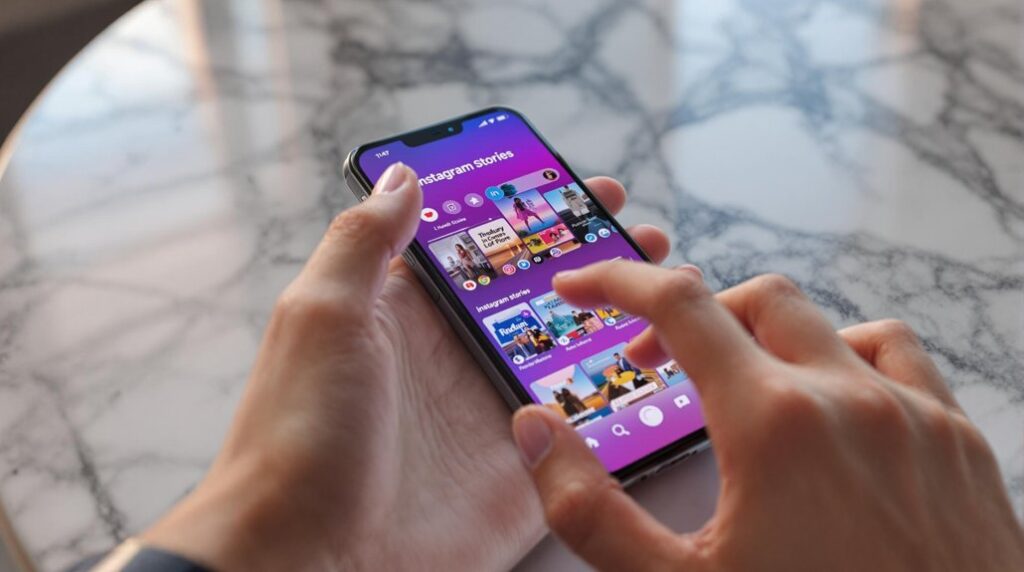To supercharge your Instagram ad campaigns, start by setting clear objectives and defining key performance indicators (KPIs). Monitor your ad performance closely and adjust targeting parameters as needed. Optimize your ad creatives by testing different visuals, headlines, and calls-to-action (CTAs). Don't forget to experiment with varied ad formats and implement A/B testing for best results. Adjust your bidding strategy and budget allocation to maximize cost-effectiveness. Use ad scheduling to reach your audience at peak times and leverage remarketing strategies for better engagement. Implement these steps effectively to see substantial improvements in your campaign performance—you'll discover more advanced tactics ahead.
Key Takeaways
- Track key metrics like impressions, clicks, and conversions to gauge ad performance.
- Conduct A/B testing on visuals, headlines, and CTAs to identify high-performing elements.
- Utilize Facebook Business Manager for detailed data analysis and campaign adjustments.
- Adjust audience targeting based on performance data to improve engagement and conversions.
- Optimize bidding strategies and budget allocation to maximize cost-effective ad spend.
Set Clear Campaign Objectives
Setting clear campaign objectives is essential for measuring success and guiding your ad strategy effectively. When you articulate specific goals like brand awareness or conversions, you create a solid foundation for your campaign's success.
Start by identifying what you want to achieve—whether it's increasing follower engagement, driving website traffic, or boosting sales.
Objective alignment is vital. Your objectives should align with your overall business goals and the desired outcomes of your Instagram ad campaign. For example, if your primary aim is to enhance brand awareness, your content and strategies should focus on reach and impressions. On the other hand, if conversions are your target, emphasize click-through rates and actions taken on your website.
Measurable objectives allow for precise performance tracking. By setting clear, quantifiable goals, you can track key metrics and analyze how well your campaign is performing.
This data-driven approach helps you identify areas for improvement and optimize accordingly. For instance, if a particular ad isn't driving the expected engagement, you can tweak the content or targeting parameters to better meet your objectives.
Define Key Performance Indicators
Establishing Key Performance Indicators (KPIs) is vital for measuring the effectiveness and success of your Instagram ad campaigns. KPIs like reach, impressions, click-through rate (CTR), and conversion rate provide quantifiable data that's essential for performance optimization. By conducting thorough KPI analysis, you can gauge how well your ads are resonating with your target audience and achieving your campaign objectives.
Metric tracking is your roadmap to understanding ad performance. Regularly monitoring KPIs helps you track progress, identify emerging trends, and pinpoint areas needing improvement. Setting benchmarks for these metrics allows you to compare current performance against past campaigns, giving you a clear picture of your ad's effectiveness over time.
Audience refinement is another strategic benefit of KPI analysis. By evaluating which segments of your audience are most responsive, you can adjust your targeting and optimize ad creative for better results. This data-driven approach ensures your ads aren't just seen but are also compelling enough to drive desired actions.
Monitor Ad Performance
To effectively monitor your Instagram ad performance, regularly track key metrics like impressions, engagement, and conversion rates.
Use analytics tools to fine-tune audience targeting and enhance ROI.
Track Key Metrics
Consistently monitoring key metrics like impressions, engagement, clicks, and conversions is crucial for evaluating the performance of your Instagram ad campaign. By delving into data analysis, you can uncover valuable insights that will help you fine-tune your strategy.
Performance tracking allows you to measure the reach of your ads, see how many users are interacting with your content, and understand the effectiveness of your calls to action.
When you analyze metrics such as reach, CTR (click-through rate), and ROI (return on ad spend), you can identify patterns and trends that inform your decision-making process. For instance, a high CTR indicates that your ad is compelling enough to drive users to take action, while a low ROI might suggest the need to rework your budget or ad creative.
Utilize this data to continuously optimize your campaigns. If you notice that certain ads perform better at specific times or with particular audience segments, you can adjust your strategy accordingly.
Performance tracking isn't a one-time task; it's an ongoing process that helps you stay agile and responsive to changes in user behavior. By leveraging data-driven insights, you can guarantee your Instagram ad campaigns deliver maximum value and achieve your marketing goals.
Adjust Audience Targeting
Analyzing ad performance regularly gives you the insights needed to adjust audience targeting strategies for maximum impact. By monitoring metrics like impressions, engagement rates, and click-through rates, you can assess how well your ads resonate with your audience. This data-driven approach allows you to refine your audience segmentation, ensuring that you're targeting the right demographics, interests, and behaviors.
To achieve effective targeting optimization, leverage tracking tools that provide real-time metrics. These tools help you identify which audience segments are most responsive to your ads. Use this information to adjust your targeting parameters, such as age, location, and interests, to enhance engagement and reach.
Experimentation is key in this process. Apply various testing methods to see which audience segments yield the highest engagement and conversion rates. For instance, A/B testing different segments can highlight which group is more profitable for your campaign. Continuously iterate based on your findings to keep your targeting strategies sharp and effective.
Evaluate ROI Effectiveness
Maximizing your Instagram ad campaign's effectiveness starts by closely monitoring key metrics like impressions, engagement, and conversions through Instagram Insights. Regularly tracking these metrics allows you to evaluate campaign success and identify areas needing improvement. Pay special attention to your cost per result and the revenue generated from your campaigns to gauge your return on investment (ROI) accurately.
Utilize key performance indicators (KPIs) such as click-through rate (CTR) and conversion rate to measure how well your ads are performing. A high CTR indicates that your ad is compelling enough to encourage users to click, while a strong conversion rate shows that your audience is taking desired actions.
To improve ad efficiency, refine your targeting parameters based on performance data. Adjusting your audience targeting can help you reach the most engaged users, thereby optimizing your ROI.
Additionally, making data-driven decisions about ad creative elements like visuals, copy, and call-to-action (CTA) can greatly enhance your campaign's effectiveness. Continuously testing and optimizing these elements ensures that your ads remain relevant and engaging, leading to better overall results.
Refine Targeting Parameters
To optimize targeting parameters effectively, utilize audience demographics, interests, and behaviors to amplify the relevance and impact of your Instagram ad campaigns. Begin by implementing targeting refinement strategies that focus on thorough audience analysis. By examining Instagram Insights, you can gain valuable data on your followers' age, gender, location, and activity patterns. This detailed audience analysis helps create more pertinent and influential ads.
Next, concentrate on ad relevance enhancement by identifying responsive segments within your audience. Experiment with different audience segments to see which groups are most engaged with your content. For example, you might find that younger audiences respond better to video ads, while older demographics prefer static images. Adapting your ads to these preferences can greatly boost engagement and conversion rates.
Regularly adjust your targeting parameters based on performance data. If certain segments aren't responding well, don't hesitate to tweak your criteria. This continuous optimization ensures your ads reach the right people at the right time. Remember, the more precise your targeting, the more effective your campaign will be. Keep refining and analyzing to maintain a dynamic and successful Instagram ad strategy.
Optimize Ad Creative
After refining your targeting parameters, focus on optimizing ad creative to captivate your audience and drive higher engagement. Start by experimenting with different visuals, headlines, ad copy, and CTAs. Use Instagram Insights for creative analysis to determine which components resonate best with your audience.
Bright colors, emotive language, and clear messaging can greatly boost engagement optimization.
Diversify your approach by testing various ad formats, such as photo ads, video ads, carousel ads, and collection ads. Each format offers unique opportunities to showcase your products or services and engage users differently. For example, video ads may capture attention more effectively, while carousel ads allow for detailed storytelling.
Continuously monitor performance data and iterate your ad creative accordingly. If a particular visual or headline consistently drives higher engagement, incorporate similar elements in future campaigns. Conversely, if certain aspects underperform, adjust or replace them.
This ongoing process of creative analysis and refinement is essential for maximizing your ad campaign's impact.
Adjust Bidding and Budget
To maximize your Instagram ad campaign's effectiveness, you need a flexible bid strategy aligned with your goals. Allocate your budget wisely by setting daily or lifetime limits, and monitor metrics to guarantee cost-effective spending.
Experiment with CPC and CPM bidding options to find what works best for your audience and objectives.
Flexible Bid Strategies
Maximize your ad reach and engagement by dynamically adjusting your bidding and budget in real-time based on data insights. Bid strategy optimization is essential for ensuring that your Instagram ad campaigns are both effective and cost-efficient. By making real-time adjustments to your bidding strategies, you can maximize ad reach and engagement, ultimately driving better results.
Start by experimenting with different bidding strategies to find the most cost-effective approach for your campaigns. This might mean shifting from a manual bid strategy to an automated one, or vice versa, depending on what the data tells you. Keep a close eye on how these adjustments impact your campaign's performance metrics, ensuring they align with your objectives and budget constraints.
Utilize tools like Facebook Business Manager to manage and customize your bidding strategies seamlessly. This platform allows you to implement flexible bid strategies that can be tailored to your specific campaign needs. With its robust data analytics, you can monitor and tweak your bids in real time, ensuring optimal performance.
Budget Allocation Techniques
Effective budget allocation techniques are crucial for maximizing your Instagram ad campaigns, allowing you to adjust bidding and budget dynamically based on performance data.
Start by leveraging the power of performance analysis. Monitor key metrics like cost per click (CPC) and return on ad spend (ROAS) to gain insights into which ads are performing well and which need adjustments.
To achieve budget optimization, experiment with different budget allocations. Test various spending levels to determine the best balance between cost and results.
Use Facebook Business Manager to control your ad spend effectively. This platform lets you adjust budgets in real-time and apply changes based on up-to-date performance data, ensuring that your budget is always aligned with your campaign goals.
Automate your budget management by implementing automated rules in Facebook Business Manager. These rules can dynamically adjust your budget allocation, responding to performance indicators without requiring constant manual intervention.
For instance, if a particular ad set shows high engagement and low CPC, an automated rule can increase its budget to maximize ROI.
Cost-Effective Ad Spend
Adjusting your bidding strategy on Instagram is vital for optimizing ad delivery and reaching your target audience cost-effectively. By performing a thorough ad spend analysis and leveraging audience segmentation, you can guarantee your budget is allocated efficiently.
Start by experimenting with different budget allocations to find the sweet spot between maximizing results and minimizing costs.
Utilize automatic bidding to let Instagram adjust your bid to secure the most actions at the best price. This method takes the guesswork out of bid optimization and ensures you're getting the most bang for your buck.
However, to maintain control over your expenses, set bid caps to limit the maximum amount you're willing to pay for specific actions. This approach ensures cost efficiency by preventing overspending on less impactful engagements.
Regular monitoring of your ad performance is essential. Analyze data frequently and be prepared to adjust your bidding and budget based on performance metrics. This dynamic approach allows you to optimize cost-effectiveness continually.
Test Different Ad Formats
How can you determine which Instagram ad format will drive the most engagement for your campaign? The key lies in A/B testing strategies and creative experimentation. By testing different ad formats like Story Ads, Photo Ads, Video Ads, Carousel Ads, and Collection Ads, you can pinpoint which one resonates best with your audience.
Here's how to start:
- A/B Testing Strategies: Experiment with two ad formats simultaneously to compare engagement rates and conversion rates. For instance, run a Photo Ad against a Video Ad and analyze which garners more clicks and interactions.
- Creative Experimentation: Tailor your content to each format. Use engaging visuals and storytelling for Video Ads, while leveraging the swipe feature in Carousel Ads to showcase multiple products or features.
- Tracking Metrics: Monitor key performance indicators (KPIs) like engagement rates and conversion rates. This data will help you understand which format is most effective.
Implement Ad Scheduling
Ad scheduling empowers you to strategically time your Instagram ads, maximizing engagement and conversion rates by targeting your audience when they're most active. By leveraging time zone optimization, you can guarantee your ads appear at the right moments, irrespective of where your audience is located. This is essential because different time zones mean different peak activity periods.
Start by analyzing your audience's behavior using Instagram's analytics tools. Look for patterns in when your followers are most engaged. You'll often find that certain times and days see higher activity, known as peak hours. Peak hours targeting allows you to align your ad schedule with these high-engagement periods, making your campaigns more effective.
Experimentation is key. Test various scheduling options to determine what works best for your specific audience. For instance, if your target demographic is most active during their lunch breaks or evenings, schedule your ads accordingly. Continually analyze performance data to refine your strategy. Effective ad scheduling isn't a one-time task—it's a dynamic process that requires regular adjustments based on real-time insights.
Ultimately, by implementing ad scheduling with a focus on time zone optimization and peak hours targeting, you'll greatly enhance the reach and impact of your Instagram ad campaigns.
Utilize Remarketing Strategies
Remarketing strategies on Instagram leverage past user interactions to boost conversion rates and keep your brand top of mind. By targeting users who've already engaged with your brand, you can effectively remind them of products they viewed but didn't purchase. This approach can lead to a 70% higher conversion rate compared to regular ads.
Here's how you can optimize your Instagram remarketing efforts:
- Dynamic Ads: Use them to show personalized content based on users' past interactions. This personalization technique guarantees that your ads are relevant and engaging, driving higher retention.
- Customer Segmentation: Group your audience based on their behaviors and interactions with your brand. This targeted segmentation allows you to tailor your engagement strategies more precisely.
- Retention Tactics: Implement strategies to keep your brand top of mind for potential customers. Consistent remarketing helps drive higher ROI by maintaining ongoing visibility and interest.
Frequently Asked Questions
How Do I Optimize My Instagram Ad Campaign?
Optimize your Instagram ad campaign by doing A/B testing on ad creatives and audience segmentation. Regularly analyze performance metrics like engagement and conversion rates, and adjust targeting based on data to enhance effectiveness and reach.
How to Analyze Instagram Ads?
To analyze Instagram ads, use audience insights to understand your demographic reach. Track engagement metrics like impressions and CTR to gauge effectiveness. Strategically assess visuals and CTAs to make sure they resonate and drive desired actions.
How Do I Optimize My Ad Campaign?
To optimize your ad campaign, refine your audience segmentation based on data insights. Continuously conduct content testing, adjusting visuals, headlines, and CTAs. Regularly monitor performance and iterate to enhance engagement, conversion rates, and overall effectiveness.
How Do I Run a Successful Ad Campaign on Instagram?
To run a successful ad campaign on Instagram, focus on precise audience targeting and compelling visual storytelling. Use data-driven insights to refine your demographics and interests, and continuously test creative elements for best engagement and conversions.
Conclusion
By setting clear objectives, defining key metrics, and monitoring performance, you'll gain valuable insights into your Instagram ad campaigns.
Refine your targeting, optimize ad creatives, and adjust bids and budgets to maximize ROI.
Test various formats and implement strategic scheduling for better engagement.
Finally, leverage remarketing to re-engage users.
With a data-driven, strategic approach, your Instagram ad campaigns will be more effective and efficient, driving better results and higher returns.




